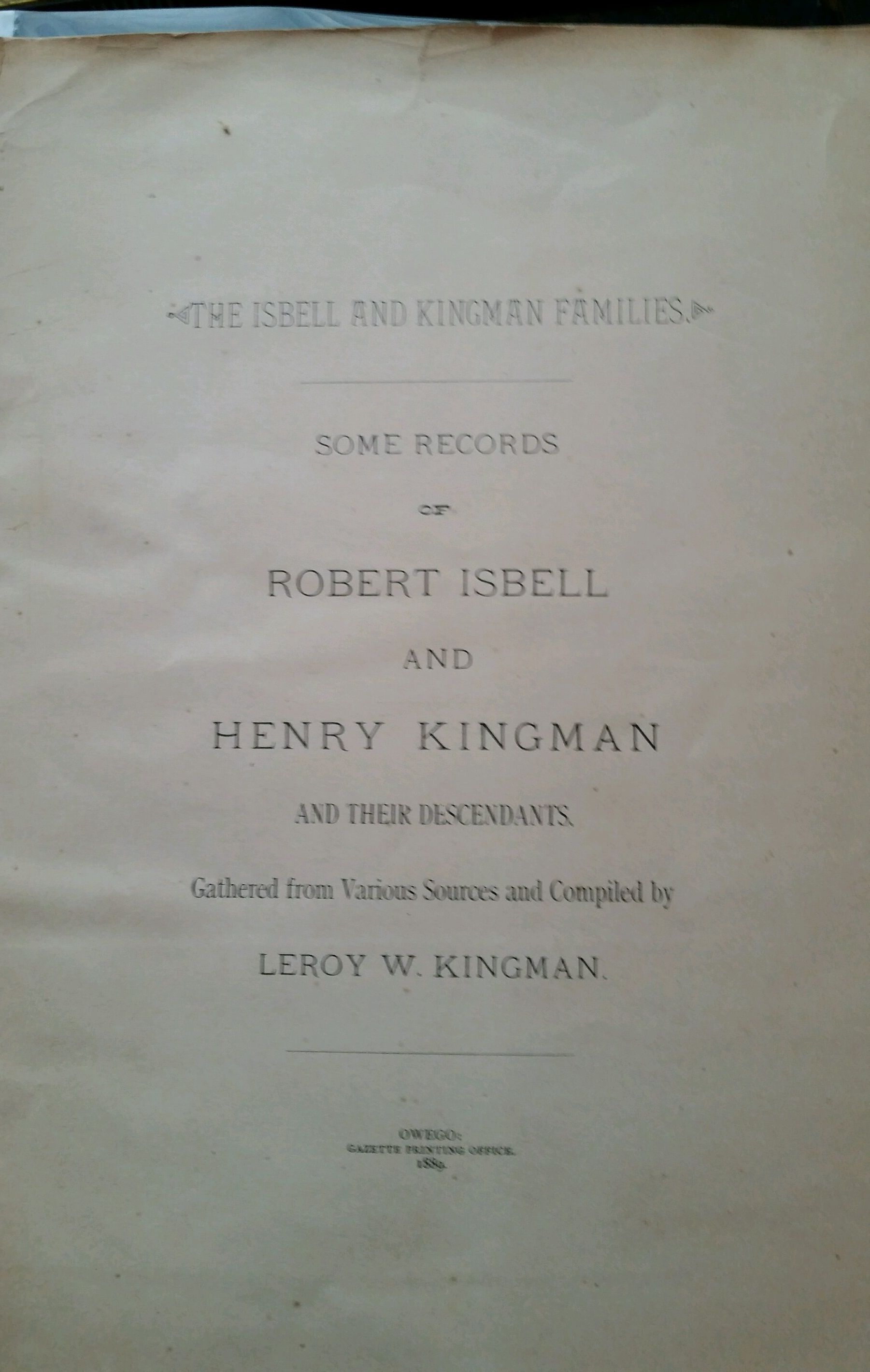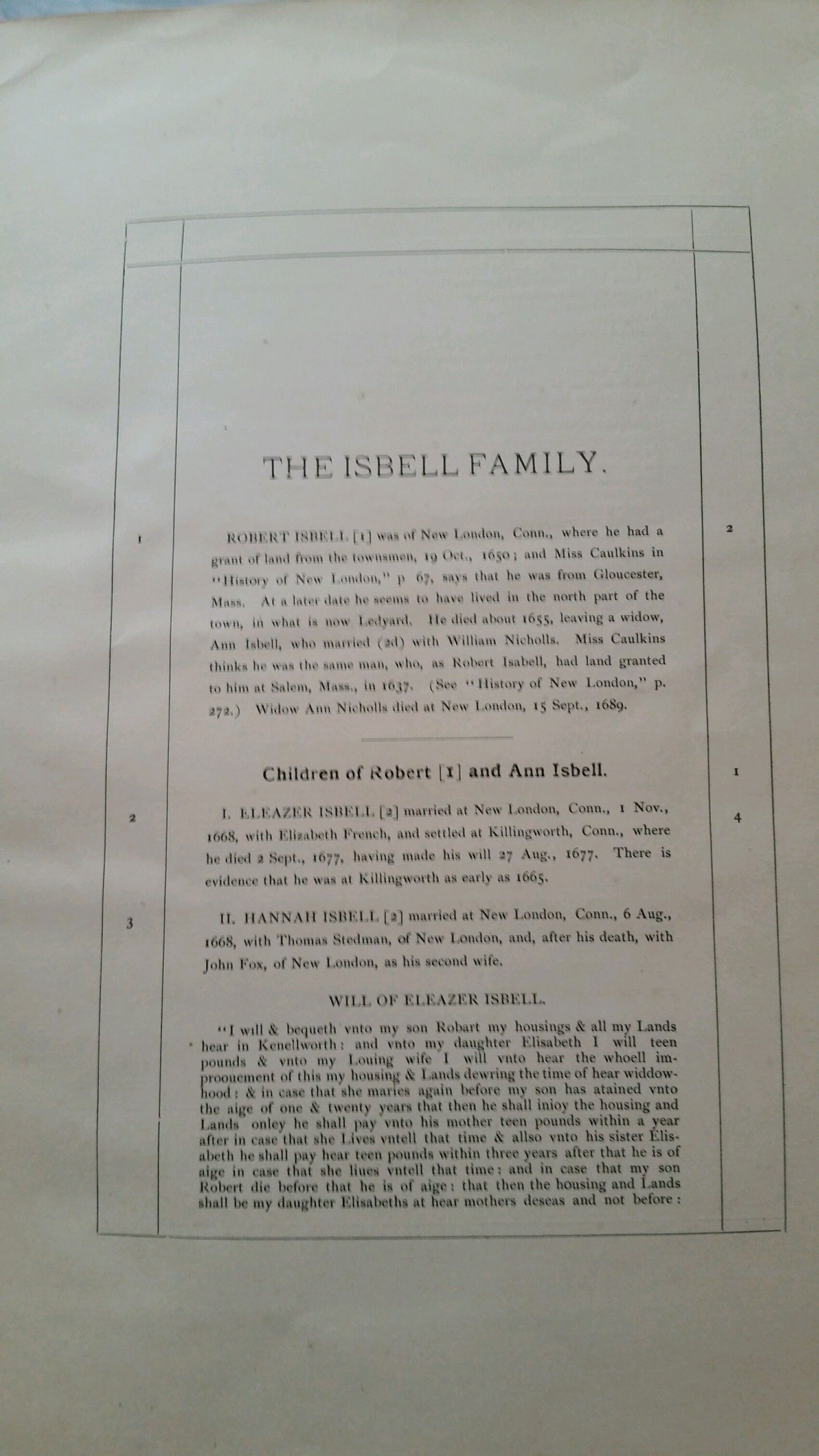"Our Second Boat Ship List: In Second Boat," by Carol Tyler King, Downeast Ancestry (Machias, ME), vol. 16:4 (Fall 1996), pp. 14-20: lists Robert Isbell arrival in Salem 1635
Founders of Early American Families: Emigrants from Europe, 1607-1657 (1975) by Meredith B. Colket Jr. lists Robert Isbell's immigration to Salem as 1636.
A Genealogical Register of the First Settlers of New-England (1935) by John Farmer lists Robert "Isabell" as immigrating to Salem 1637
From The Descendants of Robert Isbell (1944) by Edna Warren Mason:
He was first noticed at Salem, Mass., where he became a Proprietor. In 1636 his name appears on the list of Grants of Land known as Land Grants A, also on the list made by Roger Conant of the Division of the marsh and meadow, ordered to be assigned and laid out to the families at a Town Meeting, December 25, 1637, known as Land Grants B. The figure 1 before his name indicates the number of persons in his family, and the figure 2, after his name, that he received half an acre. Robert Isbell and wife, Ann, lived in that part of Salem which in 1645 became Manchester. In 1651, before leaving for New London, "Robert Isbell of Manchester, carpenter, for 15 pounds sold his dwellinghouse and 49 acres of land with his partition of meadow which is one half acre allotted to him in 1638 by Richard Norman."
October 19, 1650, grants of land were made by the townsmen of New London to "Mr. Richard Blynman, Obadiah Bruen, Hughe Calkin, Hughe Roberts, John Coite, Andrew Lester, James Averye and Robert Isbell." Mr. Blynman was a minister at Gloucester, Mass., engaged to become the minister at Pequot Plantations as New London was then called. The others were a party of his friends from Gloucester and Salem who purposed to come with him and came on to make preparatory arrangements. Early in 1651, New Street, in rear of the town plot, was opened for the accommodation of the Cape Ann Company, as this little group was known. This was designated as "beyond the brook and the ministry lot." It was made into houselots and called Cape Ann Lane, nine lots on this street of six acres each. Beginning at the lower end Hughe Calkins had the first lot by the Lyme Road, or highway to Nahantic, next him, his son-in-law, Hughe Roberts, then John Coite, Andrew Lester, James Averye, Robert Allyn, William Meads, William Hough and Robert Isbell. Later, lands near New London, were laid out to Robert Isbell, Capt. John Avery and John Pickett, near Jonathan Brewsters in Poquetannock, and those were called the "Poquetannock Grants." December 1659, his house on New Street was sold to William Hough, and in 1665 the farm in the northern part of the town in what is now (1943) Ledyard and on which he had lived, was bought by George Geer."
"In December, 1659, he [Deacon William Douglas] purchased of William Hough of New London, Connecticut, the house that was Robert Isbell's in New Street." {Colonial Families of the United States of America [1919] by GEORGE NORBURY MACKENZIE, p. 193.) Deacon William Douglas (1610-1682) is at Findagrave 50191722.
In 1665, Eleazer Isbell sold 150 acres that had belonged to his father, Robert Isbell, including one of his homes, to George Geer (1621-1726) and Sarah Allyn Geer (1642-1725) (FindaGrave 41346410). Historians identify their great-grandson Thomas Geer as builder (c1796) of the house there now. Thomas Geer "the builder" sold it in 1799 to his 3rd-cousin Capt. Christopher Allyn's son, Capt. Alexander Allyn. It remained in the Allyn family until 1904, when George St. John Sheffield, a benefactor to Yale rowing, acquired it, and in 1907 Yale University purchased it. In 1878 the annual Yale-Harvard Regatta, begun in 1852, moved permanently to Gales Ferry (Ledyard, formerly New Haven). A large addition was built onto the Geer structure to house the Yale rowing team. A large boat house was designed by architect James Gamble Rogers who designed several Yale college library buildings. "Payne Whitney, 1898 heavyweight rowing captain, also contributed significantly to Gales Ferry." The Gales Ferry compound grew to include several historic Allyn houses, among others, which may have been on Isbell property also.
"Our Second Boat Ship List: In Second Boat," by Carol Tyler King, Downeast Ancestry (Machias, ME), vol. 16:4 (Fall 1996), pp. 14-20: lists Robert Isbell arrival in Salem 1635
Founders of Early American Families: Emigrants from Europe, 1607-1657 (1975) by Meredith B. Colket Jr. lists Robert Isbell's immigration to Salem as 1636.
A Genealogical Register of the First Settlers of New-England (1935) by John Farmer lists Robert "Isabell" as immigrating to Salem 1637
From The Descendants of Robert Isbell (1944) by Edna Warren Mason:
He was first noticed at Salem, Mass., where he became a Proprietor. In 1636 his name appears on the list of Grants of Land known as Land Grants A, also on the list made by Roger Conant of the Division of the marsh and meadow, ordered to be assigned and laid out to the families at a Town Meeting, December 25, 1637, known as Land Grants B. The figure 1 before his name indicates the number of persons in his family, and the figure 2, after his name, that he received half an acre. Robert Isbell and wife, Ann, lived in that part of Salem which in 1645 became Manchester. In 1651, before leaving for New London, "Robert Isbell of Manchester, carpenter, for 15 pounds sold his dwellinghouse and 49 acres of land with his partition of meadow which is one half acre allotted to him in 1638 by Richard Norman."
October 19, 1650, grants of land were made by the townsmen of New London to "Mr. Richard Blynman, Obadiah Bruen, Hughe Calkin, Hughe Roberts, John Coite, Andrew Lester, James Averye and Robert Isbell." Mr. Blynman was a minister at Gloucester, Mass., engaged to become the minister at Pequot Plantations as New London was then called. The others were a party of his friends from Gloucester and Salem who purposed to come with him and came on to make preparatory arrangements. Early in 1651, New Street, in rear of the town plot, was opened for the accommodation of the Cape Ann Company, as this little group was known. This was designated as "beyond the brook and the ministry lot." It was made into houselots and called Cape Ann Lane, nine lots on this street of six acres each. Beginning at the lower end Hughe Calkins had the first lot by the Lyme Road, or highway to Nahantic, next him, his son-in-law, Hughe Roberts, then John Coite, Andrew Lester, James Averye, Robert Allyn, William Meads, William Hough and Robert Isbell. Later, lands near New London, were laid out to Robert Isbell, Capt. John Avery and John Pickett, near Jonathan Brewsters in Poquetannock, and those were called the "Poquetannock Grants." December 1659, his house on New Street was sold to William Hough, and in 1665 the farm in the northern part of the town in what is now (1943) Ledyard and on which he had lived, was bought by George Geer."
"In December, 1659, he [Deacon William Douglas] purchased of William Hough of New London, Connecticut, the house that was Robert Isbell's in New Street." {Colonial Families of the United States of America [1919] by GEORGE NORBURY MACKENZIE, p. 193.) Deacon William Douglas (1610-1682) is at Findagrave 50191722.
In 1665, Eleazer Isbell sold 150 acres that had belonged to his father, Robert Isbell, including one of his homes, to George Geer (1621-1726) and Sarah Allyn Geer (1642-1725) (FindaGrave 41346410). Historians identify their great-grandson Thomas Geer as builder (c1796) of the house there now. Thomas Geer "the builder" sold it in 1799 to his 3rd-cousin Capt. Christopher Allyn's son, Capt. Alexander Allyn. It remained in the Allyn family until 1904, when George St. John Sheffield, a benefactor to Yale rowing, acquired it, and in 1907 Yale University purchased it. In 1878 the annual Yale-Harvard Regatta, begun in 1852, moved permanently to Gales Ferry (Ledyard, formerly New Haven). A large addition was built onto the Geer structure to house the Yale rowing team. A large boat house was designed by architect James Gamble Rogers who designed several Yale college library buildings. "Payne Whitney, 1898 heavyweight rowing captain, also contributed significantly to Gales Ferry." The Gales Ferry compound grew to include several historic Allyn houses, among others, which may have been on Isbell property also.
Family Members
Advertisement
Explore more
Sponsored by Ancestry
Advertisement








